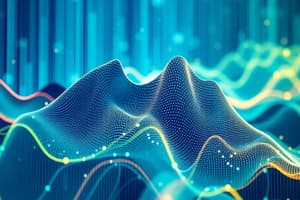Podcast
Questions and Answers
What is the first stage of the data analysis process?
What is the first stage of the data analysis process?
- Clean
- Analyze
- Identify (correct)
- Collect
Which technique is primarily used in the Analyze stage of the data analysis process?
Which technique is primarily used in the Analyze stage of the data analysis process?
- Statistical analysis (correct)
- Data interpretation
- Data cleaning
- Data collection
In which stage of the data analysis process would a researcher address data quality issues such as duplicates and formatting errors?
In which stage of the data analysis process would a researcher address data quality issues such as duplicates and formatting errors?
- Clean (correct)
- Identify
- Interpret
- Collect
What type of insights does decision support in data analysis provide?
What type of insights does decision support in data analysis provide?
Which application of data analysis is most closely associated with improving patient outcomes?
Which application of data analysis is most closely associated with improving patient outcomes?
What is the primary aim of data analysis?
What is the primary aim of data analysis?
Which of the following is NOT one of the primary objectives of data analysis?
Which of the following is NOT one of the primary objectives of data analysis?
Which statistical measures are primarily used in Descriptive Statistics?
Which statistical measures are primarily used in Descriptive Statistics?
What does Exploratory Data Analysis (EDA) primarily involve?
What does Exploratory Data Analysis (EDA) primarily involve?
Pattern recognition in data analysis can involve which type of techniques?
Pattern recognition in data analysis can involve which type of techniques?
Flashcards
Data Analysis
Data Analysis
The process of collecting, modeling, and analyzing data using statistical and logical methods to find actionable insights.
Quantitative Research
Quantitative Research
Research method focusing on numbers and statistical analysis.
Qualitative Research
Qualitative Research
Research focused on understanding concepts, opinions, or experiences.
Exploratory Data Analysis (EDA)
Exploratory Data Analysis (EDA)
Signup and view all the flashcards
Data Visualization
Data Visualization
Signup and view all the flashcards
Descriptive Statistics
Descriptive Statistics
Signup and view all the flashcards
Inferential Statistics
Inferential Statistics
Signup and view all the flashcards
Data Cleaning & Preprocessing
Data Cleaning & Preprocessing
Signup and view all the flashcards
Understanding Data
Understanding Data
Signup and view all the flashcards
Pattern Recognition
Pattern Recognition
Signup and view all the flashcards
Predictive Modeling
Predictive Modeling
Signup and view all the flashcards
Decision Support
Decision Support
Signup and view all the flashcards
Data Analysis Process
Data Analysis Process
Signup and view all the flashcards
Identify (Data Analysis)
Identify (Data Analysis)
Signup and view all the flashcards
Collect (Data Analysis)
Collect (Data Analysis)
Signup and view all the flashcards
Clean (Data Analysis)
Clean (Data Analysis)
Signup and view all the flashcards
Analyze (Data Analysis)
Analyze (Data Analysis)
Signup and view all the flashcards
Interpret (Data Analysis)
Interpret (Data Analysis)
Signup and view all the flashcards
Data Analysis Tools
Data Analysis Tools
Signup and view all the flashcards
Business Applications
Business Applications
Signup and view all the flashcards
Healthcare Applications
Healthcare Applications
Signup and view all the flashcards
Education Applications
Education Applications
Signup and view all the flashcards
Study Notes
Data Analysis and Visualization for Teaching and Learning
- The course focuses on data analysis and visualization for teaching and learning.
- Student evaluation is based on various categories, each with assigned points.
- Participation and formative assessment: 10 points
- Ongoing assessment: 10 points
- Inquiry/Lab/Field Study Product: 20 points
- Case study, research, or problem analysis: 10 points
- Presentation or Teaching Presentation: 10 points
- Tests of concept or pedagogical knowledge: 30 points
- Culminating applied products: 10 points
- Total points: 100 points
Tools for Lab
- The course features plotting systems in R, plus basic data graphic construction.
Data Analysis
- Data analysis involves collecting, modeling, and analyzing data with various statistical and logical techniques.
- It aims to generate actionable insights for informed decision-making.
- The methods are primarily based on quantitative and qualitative research.
Primary Objectives of Data Analysis
- Understanding Data: Examining data characteristics and structure to gain insights.
- Data Cleaning and Preprocessing: Identifying and handling missing, inconsistent data, or anomalies to ensure data quality.
- Exploratory Data Analysis (EDA): Employing statistical and graphical methods to summarize, visualize, and understand dataset features.
- Descriptive Statistics: Using measures (mean, median, mode, and standard deviation) to describe the dataset's main features.
- Inferential Statistics: Making inferences and predictions about a population based on a sample, often using hypothesis testing and confidence intervals.
- Data Visualization: Representing data visually using charts, graphs, and other graphical elements for enhanced understanding and interpretation.
- Pattern Recognition: Identifying trends, patterns, and relationships in data using statistical and machine learning techniques.
- Predictive Modeling: Creating models to predict or classify data based on historical records.
- Decision Support: Giving valuable actionable insights to decision-making in various fields like business, healthcare, finance, and research.
Data Analysis Process
- The analysis process has 5 key stages:
- Identify: Determining the questions to answer, defining the analysis purpose, data requirements, and intended outcome.
- Collect: Gathering data from internal or external sources, surveys, interviews, questionnaires, and focus groups.
- Clean: Removing unwanted data (white spaces, duplicate records or formatting issues) to avoid impacts on analysis from bad data quality.
- Analyze: Using various techniques (statistical analysis) to manipulate data and extract relevant conclusions. Identifying data trends, correlations, variations, and patterns.
- Interpret: Developing courses of action based on the analysis results. Identifying clients' preferences and potential limitations.
Data Analysis Tools
- Microsoft Excel
- R
- SQL
- Python
- SPSS
- Matlab
Applications of Data Analysis
- Business: Customer segmentation, sales forecasting, and market research.
- Healthcare: Identifying patient data patterns and trends to improve patient outcomes and healthcare operations.
- Education: Measuring student performance, assessing teaching effectiveness, and improving educational programs.
Data Analysis Methods
- Quantitative Methods: Use numerical data or data turned into numbers (like gender, age) to extract valuable insights.
- Qualitative Methods: Observe non-numerical data gathered through observations (interviews, focus groups, questionnaires).
Quantitative Data
- Data in the form of counts or numbers, unique numerical value.
- Used in mathematical calculations and statistical analysis for real-life decisions.
- Examples: "How much did that laptop cost?" or measuring parameters like weight (pounds or kilograms) or cost (dollars).
Types of Quantitative Data
- Counter: Counting entities (people downloading apps).
- Measurement of Physical Objects: Measuring physical objects (cubicle sizes).
- Sensory Calculation: Using mechanisms to sense data (digital camera converting electromagnetic info).
- Projection of Data: Predicting future data using algorithms.
- Quantification of Qualitative Entities: Transforming qualitative info into numbers (online survey ratings).
Quantitative Data Collection Methods
- Surveys: Collecting data through questionnaires/online surveys.
- One-on-one Interviews: Gaining in-depth data through structured interactions.
Data Visualization
- Transforming data into a visual format (charts, graphs, and maps).
- Helps to understand trends, outliers and patterns within the data.
Task #1
- Form groups of 1, 2, 3, or 4.
- Install R studio.
- Research datasets pertinent to teaching and learning.
Studying That Suits You
Use AI to generate personalized quizzes and flashcards to suit your learning preferences.




